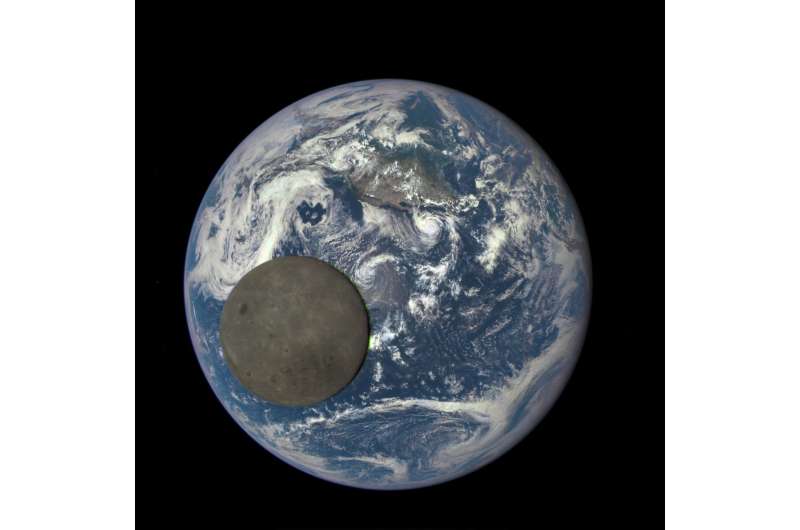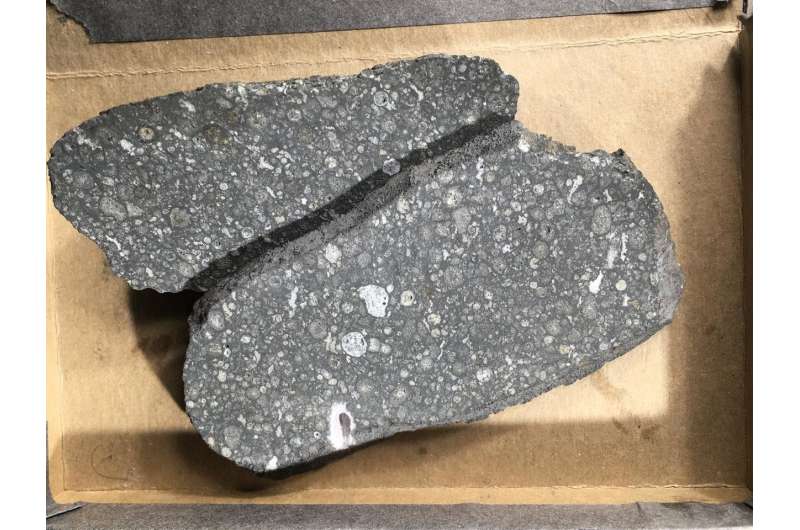March 29, 2018 report
Study suggests Earth's water was present before impact that caused creation of the moon

A team of researchers from the U.K., France and the U.S. has found evidence that suggests that most of the water on Earth was present before the impact that created the moon. In their paper published on the open access site Science Advances, the group describes their study and comparison of moon and Earth rocks, and what they found.
The prevailing theory regarding how the moon's origin is that a Mars-sized protoplanet slammed into protoplanetary Earth, and the ejected material coalesced to form the moon. The prevailing theory regarding how water came to exist on Earth is that most of it was delivered by asteroids and comets. In this new effort, the researchers present evidence that bolsters the first theory but conflicts strongly with the second.
The team studied both moon rocks brought back to Earth by the Apollo astronauts and volcanic rocks retrieved by others from the ocean floor. The researchers looked specifically at oxygen isotopes. Studying isotopes in rocks offers scientists a means for comparing material from different origins such as asteroids, planets or even comets—each tends to have its own unique composition signature.
The researchers report that oxygen isotopes from the moon and Earth are remarkably similar—they found just a three to four ppm difference between them. This finding bolsters the theory that the moon was formed from material from the Earth due to a collision. But it runs counter to the idea that water came from comets or asteroids, because if it had come from such sources, the isotopes would have differed from those found in rocks on the moon. Thus, most of the water that was present in the protoplanetary Earth likely survived the impact, suggesting it did not come from elsewhere.

The idea that water could survive such an impact has implications for the search for life beyond our solar system—exoplanets that are thought to have suffered collisions are typically removed from lists describing possible life-sustaining celestial bodies. Now, they may have to be included.
More information: Richard C. Greenwood et al. Oxygen isotopic evidence for accretion of Earth's water before a high-energy Moon-forming giant impact, Science Advances (2018). DOI: 10.1126/sciadv.aao5928
Abstract
The Earth-Moon system likely formed as a result of a collision between two large planetary objects. Debate about their relative masses, the impact energy involved, and the extent of isotopic homogenization continues. We present the results of a high-precision oxygen isotope study of an extensive suite of lunar and terrestrial samples. We demonstrate that lunar rocks and terrestrial basalts show a 3 to 4 ppm (parts per million), statistically resolvable, difference in Δ17O. Taking aubrite meteorites as a candidate impactor material, we show that the giant impact scenario involved nearly complete mixing between the target and impactor. Alternatively, the degree of similarity between the Δ17O values of the impactor and the proto-Earth must have been significantly closer than that between Earth and aubrites. If the Earth-Moon system evolved from an initially highly vaporized and isotopically homogenized state, as indicated by recent dynamical models, then the terrestrial basalt-lunar oxygen isotope difference detected by our study may be a reflection of post–giant impact additions to Earth. On the basis of this assumption, our data indicate that post–giant impact additions to Earth could have contributed between 5 and 30% of Earth's water, depending on global water estimates. Consequently, our data indicate that the bulk of Earth's water was accreted before the giant impact and not later, as often proposed.
Journal information: Science Advances
© 2018 Phys.org





















